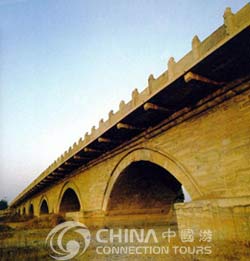
 Lugou Qiao, also known as the Marco Polo Bridge, is one of the earliest segmented stone arch bridges. The Diary of Marco Polo says, "Over this river there is a very fine stone bridge, so fine indeed, that it has very few equals in the world." The bridge is 260 meters long and has 250 marble balustrades supporting 485 carved stone lions. The people of Beijing have a saying to the effect that "the lions of the Lugou Bridge are too numerous to count".
Lugou Qiao, also known as the Marco Polo Bridge, is one of the earliest segmented stone arch bridges. The Diary of Marco Polo says, "Over this river there is a very fine stone bridge, so fine indeed, that it has very few equals in the world." The bridge is 260 meters long and has 250 marble balustrades supporting 485 carved stone lions. The people of Beijing have a saying to the effect that "the lions of the Lugou Bridge are too numerous to count".
In the Jin dynasty, the bridge was listed as the "Eight Scenic Spots of Yanjing (Beijing)" under the title "Moon over Lugou at Daybreak" which has remained throughout the Yuan, Ming, and Qing dynasties.
 At the extremes of the bridge there are two stone tablets, one recording the history of the renovation work carried out in the reign of Emperor Kangxi (1662-1722), and the other bearing the inscription "The Moon over the Lugou Bridge at Dawn" in the handwriting of Emperor Qianlong (1735-1796).
At the extremes of the bridge there are two stone tablets, one recording the history of the renovation work carried out in the reign of Emperor Kangxi (1662-1722), and the other bearing the inscription "The Moon over the Lugou Bridge at Dawn" in the handwriting of Emperor Qianlong (1735-1796).
On July 7th, 1937, the bridge featured again in China's history when the Japanese Army began its war to conquer China, known as the "Lugou Bridge Incident". This is considered by many to be the date when the war between China and Japan began.

